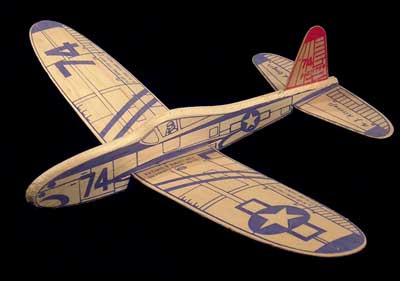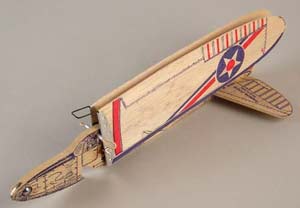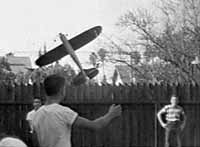Memories of Jim Walker and his
Ready-To-Fly balsa model airplanes
by Bill Weaver
When I operated my model shop during 1938-41, one of my biggest problems was explaining to someone who saw the models in my window and hanging from the ceiling that they had to be built from kits. These were adults wanting to buy an airplane for a birthday or Christmas present. They couldn't believe these models came from that box full of balsa sticks, balsa sheets, covering material, etc. with a complicated-looking plan. It was even more disappointing to smaller boys who came in wanting to buy "one of those airplanes."
 |
The 10 cent glider was the model 74 Fighter |
Fortunately, I had a line of ready-to-fly airplane models made by the American Junior (A-J) Aircraft Company of Portland, Oregon, and priced for a kid's pocketbook. These were very well mechanically and aerodynamically designed, and great flyers. They had brightly color printed balsa parts, and the balsa wings were formed in some way to have permanent camber and dihedral. All the metal parts were well designed and made. The manufacturing was so exact that when you took the model out of its box and slid the wing and stab in to their slots it was perfectly trimmed for flying. I never had a boy return one. They sold themselves by their performance.
There was a 10 cent glider with a round lead sinker glued in its nose that could do 19 stunts depending on how hard you threw it and the angle of bank. There was the rubber powered A-J
 |
American Junior Army Interceptor from 1939 |
One youngster, too small to get a full stretch of the launch rubber, had a buddy stand on a park bench holding the dowel above his head, while he pulled the model down to a full stretch. Some caught thermals and were lost high over Frederick. The Ceiling Walker was a crazy two prop helicopter that would fly straight up outdoors or would bump against the ceiling indoors.
I didn't know it then, but the genius behind A-J was Jim Walker. In 1941 he perfected control line flying and produced the A-J Fireball, the first C/L model, complete with control handle and flying lines. I saw one fly at a 1941 free flight contest in Baltimore.
I first got to know Jim Walker at the 1950 NATS held at the Dallas Naval Air Station. He was a R/C contender from the first days of R/C flying. But he also was a master showman and put  on flying demonstrations all during NATS week. He could fly three Fireballs at once, with a control handle in each hand and one attached to his hat. His Fireballs were all equipped with engine speed controls. It enabled him to do stunts like flying a Fireball around and doing his "sabre dance" - making it stop in mid air hanging on its prop and climbing up and down vertically. He would put a pin in the tail end of a Fireball and stop it over a balloon fastened to the ground and slowly back down and puncture it.
on flying demonstrations all during NATS week. He could fly three Fireballs at once, with a control handle in each hand and one attached to his hat. His Fireballs were all equipped with engine speed controls. It enabled him to do stunts like flying a Fireball around and doing his "sabre dance" - making it stop in mid air hanging on its prop and climbing up and down vertically. He would put a pin in the tail end of a Fireball and stop it over a balloon fastened to the ground and slowly back down and puncture it.
Every evening he was in the hangar-workshop demonstrating his ready-to-fly models and giving one to every kid he saw. Soon the hangar was full of Ceiling Walkers and Hornets flying around like big insects. He would put a pin in the nose of one of his 10 cent gliders and have a small boy hold a balloon. After walking about 30 - 35 feet away, he would announce that the glider will make a climbing turn over the boy's head, glide down another turn, and burst the balloon. Taking careful aim he would give it a slightly banked pitch. I never saw him miss.
He even invented a glider controlled by sound waves instead of radio waves. It would respond to blasts from a horn! Jim Walker died, probably in the late 1950s or early 60s. I think his company stopped production then. I have seen some A-J models advertised in recent years by somebody in Oregon (American Junior Classics of course).
He was an outstanding inventor, model airplane designer and flyer, precision manufacturer and showman.
Home | Jim Walker | FireWire | Air Mail | Short Takes | Fireball | Firebaby | Contact Us

